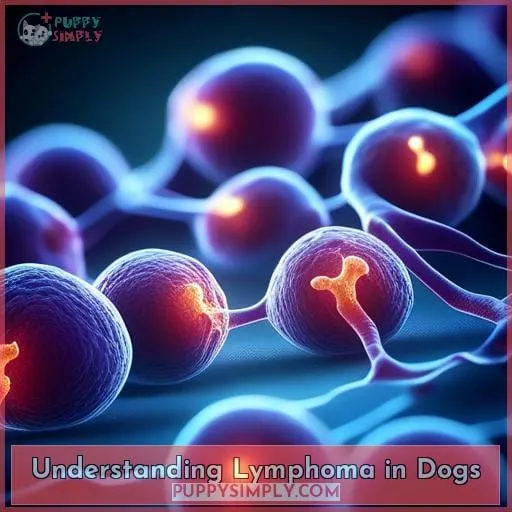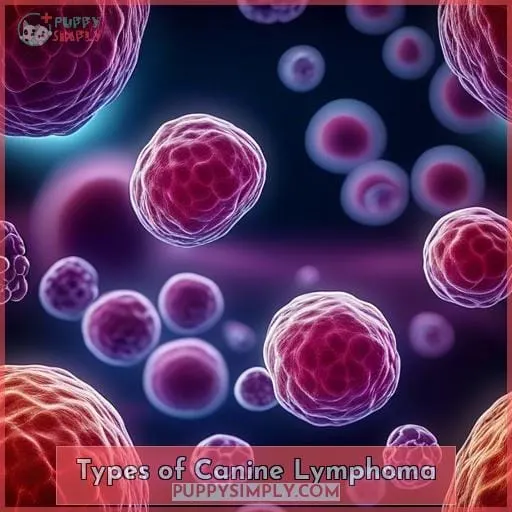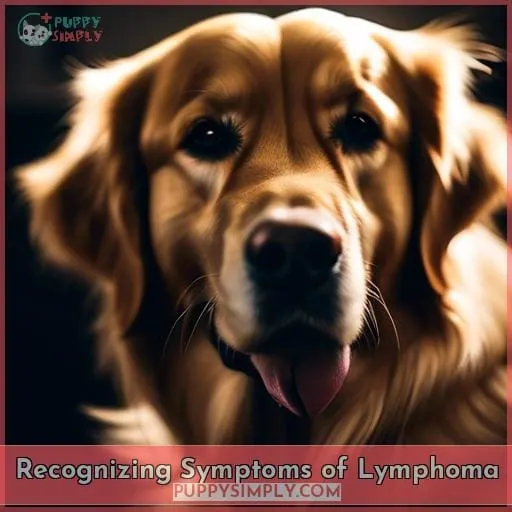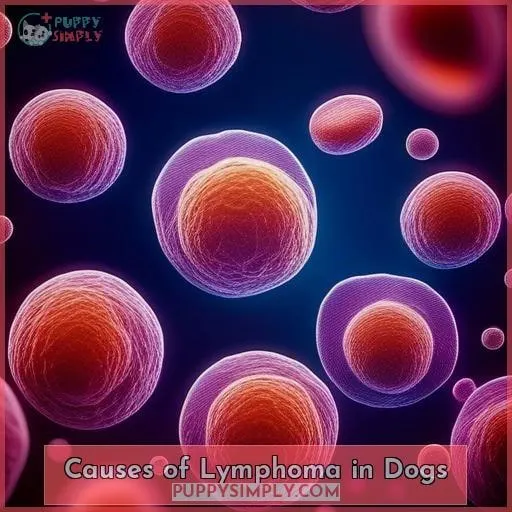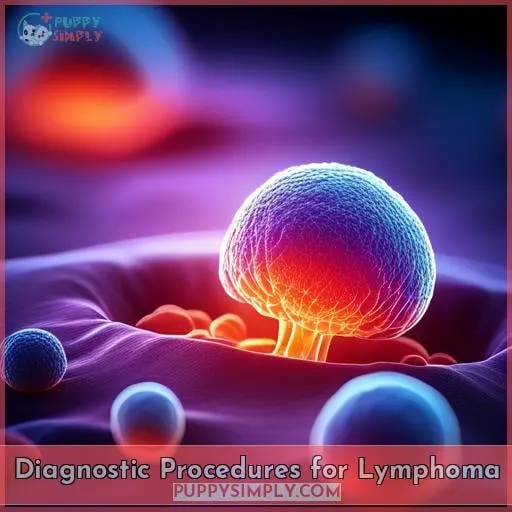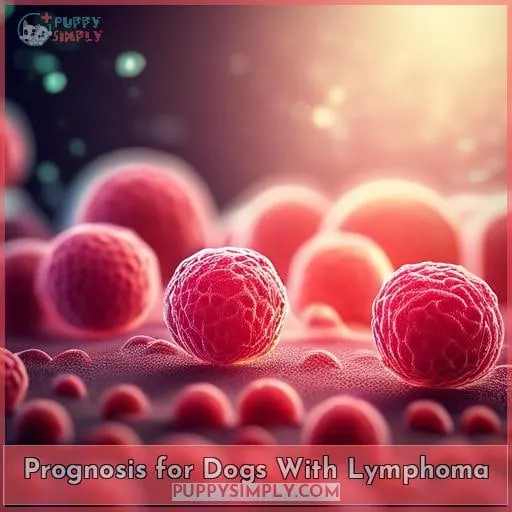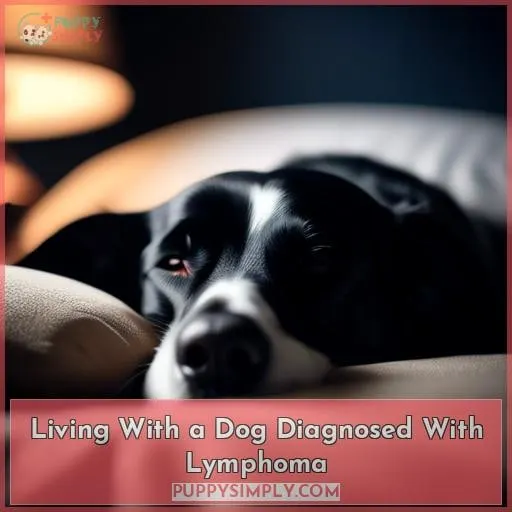This site is supported by our readers. We may earn a commission, at no cost to you, if you purchase through links.
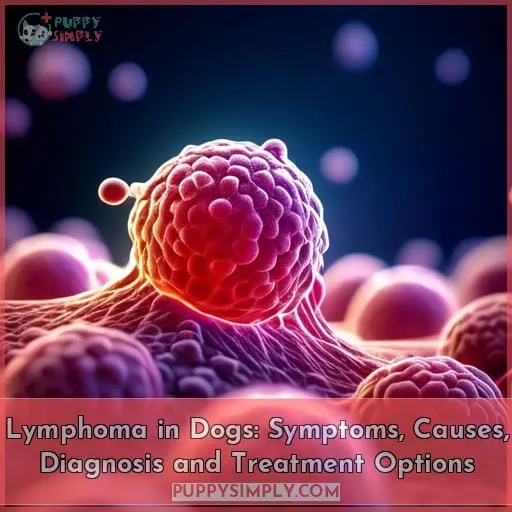 You don’t have to live in fear of lymphoma—armed with the right knowledge, you can advocate for your dog.
You don’t have to live in fear of lymphoma—armed with the right knowledge, you can advocate for your dog.
Though lymphoma often appears suddenly, early signs like lymph node swelling provide clues.
Understand the types so you know what to watch for.
With prompt diagnosis, treatment options like chemo can prolong quality life.
Knowledge brings hope. I’m here to walk this out with you.
Table Of Contents
- Key Takeaways
- Understanding Lymphoma in Dogs
- Types of Canine Lymphoma
- Recognizing Symptoms of Lymphoma
- Causes of Lymphoma in Dogs
- Diagnostic Procedures for Lymphoma
- Treatment Options for Canine Lymphoma
- Prognosis for Dogs With Lymphoma
- Living With a Dog Diagnosed With Lymphoma
- Ongoing Research and Future Directions in Canine Lymphoma Treatment
- Frequently Asked Questions (FAQs)
- What are the survival rates for dogs diagnosed with lymphoma?
- How can I help my dog cope with the side effects of chemotherapy?
- Are there any alternative or complementary therapies that can be used alongside conventional treatment for lymphoma in dogs?
- What are the long-term implications of lymphoma treatment for dogs?
- How can I prevent my dog from developing lymphoma?
- Conclusion
Key Takeaways
- Lymphoma is a common cancer in dogs originating from lymphocytes, affecting lymph nodes and the lymphatic system.
- Most common in middle-aged and older dogs, with certain breeds like Golden Retrievers, Boxers, and Scottish Terriers being predisposed.
- Different types of lymphoma exist, including multicentric, alimentary, mediastinal, and extranodal, each with varying symptoms and requiring tailored treatment approaches.
- Treatment options include chemotherapy, prednisone, surgery, or radiation therapy, and alternative therapies, with long-term survival possible, but managing costs can be challenging.
Understanding Lymphoma in Dogs
Lymphoma is a common cancer in dogs that originates from lymphocytes, a type of white blood cell.
The lymph nodes and lymphatic system are most often affected, but lymphoma can arise in other areas like the skin, intestines, and chest.
Older dogs tend to be more susceptible, but lymphoma can occur in dogs of any age.
Definition and Overview
Lymphoma’s definition is a cancer originating from lymphocytes, a type of white blood cell that’s part of the immune system.
As an overview, lymphoma in dogs commonly arises in lymph nodes but can affect other organs.
Lymphoma’s a cancer of the immune system that usually starts in lymph nodes but can spread through your dog’s body.
- Enlarged lymph nodes
- Lethargy
- Weight loss
Prevalence and Risk Factors
- Lymphoma’s prevalence in dogs and associated risk factors are important considerations after its overview and definition.
- Your dog’s chances of developing lymphoma and any risk factors depend on several aspects.
- Lymphoma is relatively common in dogs, accounting for 15-20% of new cancer diagnoses, and most common in middle-aged and older dogs.
- Several breeds are predisposed, including Golden Retrievers, Boxers, and Scottish Terriers, suggesting a possible genetic component.
- Male dogs and those neutered or spayed are also at higher risk.
Types of Canine Lymphoma
There are several different types of lymphoma that can affect dogs.
The most common are:
- Multicentric lymphoma, which first appears in the lymph nodes.
- Alimentary lymphoma, which targets the intestines.
- Mediastinal lymphoma, affecting lymph nodes in the chest.
- Extranodal lymphoma, which arises in specific organs like the skin.
Each type has different characteristic symptoms and requires tailored treatment approaches.
Multicentric Lymphoma
Lymphoma is often first noticed when a dog develops enlarged lymph nodes from multicentric lymphoma, the most common type affecting multiple lymph node regions.
This type impacts the dog’s lymphatic system function, leading to symptoms like loss of appetite, lethargy, swelling, and more.
While the root causes remain unknown, possible factors range from genetic predispositions in some breeds to viral triggers to environmental exposures.
Treatment typically involves chemotherapy, which can induce remission but has potential side effects.
Considering treatment costs alongside quality of life is key.
Alimentary Lymphoma
Your dog’s gastrointestinal lymphoma targets its intestines, causing vomiting, diarrhea, and weight loss.
These lymphoma cells invade the digestive tract’s mucosa and disrupt normal function.
Vets often recommend chemotherapy to induce remission, combined with dietary changes to ease digestive upset.
Though incurable, quality of life can be preserved with prompt, tailored treatment.
Monitoring for malnutrition and maintaining hydration are also key for comfort.
Mediastinal Lymphoma
One type affects the mediastinal lymph nodes in your dog’s chest, causing shortness of breath, difficulty breathing, and increased thirst and urination.
Treatments may include:
- Chemotherapy
- Radiation therapy
- Supportive care like diuretics and oxygen
These can help relieve symptoms, but carry risks like side effects from medications.
Seeking an accurate diagnosis and specialized veterinary oncology care is essential for the best outlook.
Extranodal Lymphoma
When lymphoma affects a specific organ in your dog’s body besides the lymph nodes, it’s called extranodal lymphoma.
As the disease progresses and involves other organs, manifestations unique to each organ arise and must be managed with specialized supportive care.
Complementary therapies like nutritional support may help dogs withstand symptoms and side effects while receiving organ-targeted treatment.
Monitoring disease stage and progression is critical, as organs like the alimentary tract can be severely impacted.
Recognizing Symptoms of Lymphoma
Lymphoma Symptoms:
Multicentric Lymphoma:
- Rapidly enlarging lymph nodes
- Lethargy
- Fever
- Anorexia
- Weakness
- Dehydration
Alimentary Lymphoma:
- Vomiting
- Abdominal pain
- Anorexia
- Diarrhea
- Weight loss
Symptoms of Multicentric Lymphoma
How do you recognize the signs of multicentric lymphoma, the most prevalent type of canine lymphoma?
Watch for abnormal swelling in your dog’s lymph nodes, often accompanied by fever, loss of appetite, weakness, and dehydration.
Should you notice any of these symptoms, it’s crucial to seek immediate veterinary attention for prompt diagnosis and treatment.
Symptoms of Alimentary Lymphoma
Next, you should familiarize yourself with the symptoms of alimentary lymphoma, which is a type of lymphoma affecting the intestines.
Watch for persistent vomiting and watery diarrhea as these are common signs.
Additionally, abdominal pain, anorexia, and weight loss can occur.
Be proactive and seek veterinary attention if your dog displays these symptoms, as early detection and intervention are crucial for a favorable outcome.
| Symptoms of Alimentary Lymphoma | Additional Information |
|---|---|
| Persistent vomiting | May be accompanied by blood or bile |
| Watery diarrhea | Can lead to dehydration if left untreated |
| Abdominal pain | May be severe and interfere with daily activities |
| Anorexia | Loss of appetite can lead to weight loss and malnutrition |
| Weight loss | Can be a sign of advanced disease |
Symptoms of Mediastinal Lymphoma
Don’t you experience shortness of breath and front leg swelling if you have mediastinal lymphoma?
This type of lymphoma, though uncommon, affects the mediastinal lymph nodes in your chest.
You may also experience increased thirst and urination.
Be sure to consult your veterinarian if these symptoms arise.
Symptoms of Extranodal Lymphoma
Extranodal lymphoma’s symptoms vary based on the specific organ it affects in your dog:
- Skin lesions
- Eye involvement
- Nervous system abnormalities
Liver and spleen involvement may lead to:
- Jaundice
- Abdominal swelling
Recognizing these diverse symptoms promptly is crucial for your dog’s well-being.
Causes of Lymphoma in Dogs
Although the exact cause of lymphoma in dogs remains elusive, genetic predispositions have been identified in specific breeds.
Possible viral triggers and environmental risk factors are actively being investigated to shed light on the disease’s origins.
Hereditary Predispositions Identified
You’ll discover several dog breeds with an increased risk of lymphoma due to their genetic makeup.
Research has identified specific breeds with a higher prevalence of the disease, suggesting a hereditary component.
While genetics play a role, it’s essential to remember that lifestyle factors and environmental exposures can also contribute to lymphoma development.
Early detection through regular checkups and understanding breed predispositions can help safeguard your furry companion’s health.
Possible Viral Triggers
Investigating a viral link to lymphoma in dogs, researchers are exploring the role of certain viruses in triggering the disease.
Retroviral infection, in particular, has gained attention due to its potential to cause lymphoma.
These viruses possess the ability to insert their genetic material into the host’s DNA, leading to uncontrolled cell growth and the development of cancer.
Understanding viral transmission, viral genetics, and the mechanisms of viral latency and oncogenesis could provide valuable insights into the pathogenesis of lymphoma in dogs.
Environmental Risk Factors
Studies suggest long-term exposure to certain chemicals, pollutants, and radiation might heighten your dog’s lymphoma risk.
Pesticides, pollution, toxins, and chemicals in the environment may contribute to the development of lymphoma.
Even your dog’s diet might play a role, with some studies suggesting a link between certain dietary factors and an increased risk of lymphoma.
Being aware of these potential environmental triggers can help you take steps to minimize your dog’s exposure and safeguard their health.
Diagnostic Procedures for Lymphoma
Let’s begin by discussing the diagnostic procedures used to detect lymphoma in dogs.
The most common test is a fine needle aspirate (FNA), where cells are removed from an enlarged lymph node or organ for examination under a microscope.
A biopsy, where a tissue sample is surgically removed, may also be performed for a more definitive diagnosis.
Baseline screening bloodwork is also conducted to assess overall health and identify any abnormalities.
Fine Needle Aspirate (FNA)
A fine needle aspirate, or FNA, is a common diagnostic procedure used to examine cells from an enlarged lymph node or organ for evidence of cancerous cells in dogs with lymphoma.
The FNA procedure involves inserting a thin needle into the affected area and withdrawing a small sample of cells.
This sample is then prepared on a slide and examined under a microscope by a pathologist.
FNA is minimally invasive, relatively inexpensive, and can often provide a definitive diagnosis.
However, it has limitations and may require additional tests for confirmation.
Training programs exist to ensure accurate FNA interpretation.
Biopsy
Next, I’ll discuss how a biopsy can also be used to diagnose lymphoma in dogs. This involves surgically removing a small sample of affected tissue for examination.
Your veterinarian will decide the biopsy timing and site based on your dog’s symptoms and the suspected location of the lymphoma.
While biopsies are generally safe, there are potential complications like infection or bleeding.
If a biopsy isn’t feasible, alternative diagnostic methods may be considered.
Baseline Screening Bloodwork
Your veterinarian’s baseline screening bloodwork will look for abnormalities in your dog’s blood that may indicate lymphoma.
This blood test analysis involves:
- Interpreting bloodwork results
- Monitoring blood parameters
To evaluate:
- Anemia
- Platelet counts
Deviations from normal values can provide clues about the presence and extent of lymphoma.
Additional Tests
You may undergo additional tests, like immunohistochemistry and flow cytometry, to further characterize the lymphoma cells.
Diagnostic imaging, such as X-rays and ultrasounds, may be used to assess the extent of the lymphoma’s spread.
A bone marrow aspiration may be performed to check for lymphoma cells in the bone marrow.
Genetic testing may also be recommended to determine if there’s a genetic predisposition to lymphoma in your dog.
Treatment Options for Canine Lymphoma
Let’s consider the three most common treatment options for canine lymphoma:
- Chemotherapy: The most effective and commonly used treatment.
- Prednisone: Often used for palliative care.
- Surgery or radiation therapy: May be appropriate for certain types of low-grade localized lymphoma.
Chemotherapy
Chemotherapy remains the mainstay treatment for canine lymphoma, often leading to remission and improved quality of life.
However, it’s crucial to understand potential chemotherapy side effects and discuss drug resistance concerns with your veterinarian.
Alternative therapies may complement conventional treatment, but their efficacy varies.
Long-term survival is possible, but managing costs can be challenging.
Prednisone
In conjunction with chemotherapy, your veterinarian may prescribe prednisone, a corticosteroid, to help alleviate symptoms and extend your dog’s survival time.
Prednisone:
- Reduces inflammation
- Suppresses the immune system
- Decreases cell proliferation
Common side effects include:
- Increased appetite
- Thirst
- Urination
- Panting
- Anxiety
Long-term use can lead to serious side effects, so your veterinarian will closely monitor your dog’s response and adjust the dosage accordingly.
Surgery And/or Radiation
Surgical excision or radiation therapy might be your best options when lymphoma is localized and hasn’t spread elsewhere.
Surgery timing depends on your dog’s overall health and the lymphoma’s location.
Recovery care involves managing incision sites or radiation side effects.
Radiation therapy might cause skin irritation, while surgery can lead to pain or infection.
Discuss alternative treatments with your vet if surgery or radiation isn’t suitable.
Prognosis for Dogs With Lymphoma
Depending on the type and stage of lymphoma, your dog’s prognosis will vary.
With aggressive treatment, many dogs with lymphoma can achieve long-term survival.
However, some types of lymphoma are more aggressive and may have a poorer prognosis.
Palliative care may be recommended in cases where a cure isn’t possible, focusing on managing symptoms and providing comfort.
The emotional toll of caring for a dog with lymphoma can be significant.
Support groups and veterinary social workers can provide guidance and emotional support during this challenging time.
Living With a Dog Diagnosed With Lymphoma
- After receiving a lymphoma diagnosis for your beloved dog, you’ll need to make lifestyle adjustments to support their well-being during treatment.
Emotional Support
- Provide your dog with love and affection.
- Create a positive and stress-free environment.
-
Consider joining a support group for pet owners facing similar challenges.
Nutrition Management
- Work closely with your veterinarian to design a nutritious and easily digestible diet.
-
Monitor their food and water intake, ensuring they stay hydrated and maintain a healthy weight.
Holistic Treatments
- Explore complementary therapies like acupuncture, massage, and herbal supplements to manage discomfort and improve their quality of life.
- Discuss these options with your veterinarian to ensure they align with the treatment plan.
Ongoing Research and Future Directions in Canine Lymphoma Treatment
As we come to terms with the challenges of living with a canine companion battling lymphoma, it’s essential to acknowledge the tireless efforts of researchers and clinicians pushing the boundaries of treatment.
The future of canine lymphoma management is brimming with promise, fueled by ongoing research and groundbreaking advancements.
Targeted Therapies:
- Precisely targeting cancer cells
- Minimizing side effects
Novel Drug Combinations:
- Synergistic effects for enhanced efficacy
- Overcoming drug resistance
Immunotherapy:
- Harnessing the immune system’s power
- Unleashing the body’s natural defenses
Gene Therapy:
- Altering genetic material to combat cancer
- CAR T-cell therapy’s remarkable potential
These innovative approaches are poised to revolutionize canine lymphoma treatment, offering hope for longer, healthier lives.
Frequently Asked Questions (FAQs)
What are the survival rates for dogs diagnosed with lymphoma?
Survival rates depend on:
- The type of lymphoma
- Its stage at diagnosis
- The dog’s overall health
With aggressive treatment, some dogs achieve remission and long-term survival.
How can I help my dog cope with the side effects of chemotherapy?
Nausea and loss of appetite are common side effects of chemo in dogs.
Try offering small, frequent meals.
Bland foods like boiled chicken and rice can ease their discomfort.
Are there any alternative or complementary therapies that can be used alongside conventional treatment for lymphoma in dogs?
Explore complementary therapies to alleviate side effects and support your dog’s well-being during treatment:
- Acupuncture
- Massage
- Herbal supplements
Discuss these options with your veterinarian to ensure they align with your dog’s treatment plan.
What are the long-term implications of lymphoma treatment for dogs?
With over 30 types of lymphoma in dogs, treatment success and long-term implications vary.
Your veterinarian can guide you through the journey, offering support and expertise.
How can I prevent my dog from developing lymphoma?
Preventing lymphoma in dogs is a complex challenge due to unknown causes.
Regular checkups,
a healthy diet,
and avoiding potential environmental hazards
may offer some protection.
Consult your veterinarian for personalized advice.
Conclusion
You don’t have to be frightened by lymphoma in dogs.
You can become an advocate for your pet with the right knowledge.
Lymphoma often strikes suddenly, but early signs like lymph node swelling can provide clues.
Understand the types of lymphoma and watch for symptoms.
Prompt diagnosis can lead to treatment options like chemo, extending your dog’s quality of life.
Knowledge brings hope.
I’m here to walk this journey with you.

